After 10 hours of sleep, we were ready to face a new day. We didn't even pretend we were going to get up for sunrise. The last three days had been so busy that we decided to sleep in and relax this morning.
After our omelets, we were ready to explore Mouse's Tank![]() This is a narrow wash a Paiute renegade named "Mouse" used as a hideout. Although the rock formations were amazing at nearly every turn,
my main interest was the petroglyphs that dated back to the Anasazis. There were at least five main panels of petroglyphs chipped into the desert varnish of the rocks lining the wash.
This seemed to be a very friendly "tribe." Many of the petroglyphs had the humans holding hands. Bighorn sheep were also very popular subjects
for the petroglyphs. My favorites were the Shaman and friends, and the guy throwing rocks at the bighorn sheep.
This is a narrow wash a Paiute renegade named "Mouse" used as a hideout. Although the rock formations were amazing at nearly every turn,
my main interest was the petroglyphs that dated back to the Anasazis. There were at least five main panels of petroglyphs chipped into the desert varnish of the rocks lining the wash.
This seemed to be a very friendly "tribe." Many of the petroglyphs had the humans holding hands. Bighorn sheep were also very popular subjects
for the petroglyphs. My favorites were the Shaman and friends, and the guy throwing rocks at the bighorn sheep.
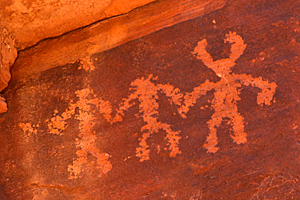
|
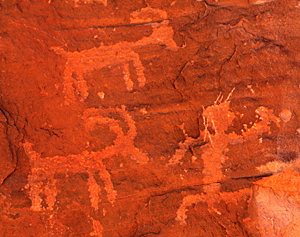
|
| Shaman & Friends | Rock Thrower |
After exploring Mouse's Tanks, we returned to camp for lunch and our afternoon siesta. We needed to build up our strength to hike out to the Fire Wave for sunset.
While driving around the park and getting the lay of the land yesterday afternoon, we were very surprised at how early sunset was in the main part of the park.
A ridge on the west side of the Mouse Tanks Road, makes sunset at least 45 minutes earlier for most of the main formations along that road, including the Fire Wave.
We were taking no chances. We left camp at 3:00 to ensure we would have plenty of time to photograph around the Fire Wave. Although the Fire Wave![]() still isn't included on any park brochures,
they now have a designated parking area for it and signage for the trail. The trail was well-marked with what appeared to be road-side reflectors along the trail.
The Fire Wave is in no way comparable to The Wave in Arizona, but it had its own unique charm. The taffy-swirled alternating colors of sandstone were amazing.
As we neared the Fire Wave, black and olive-green volcanic bombs gathered in drifts along the depressions in the sandstone. With sand dunes frozen in tans
and oranges, these dark invaders seemed oddly out of place.
still isn't included on any park brochures,
they now have a designated parking area for it and signage for the trail. The trail was well-marked with what appeared to be road-side reflectors along the trail.
The Fire Wave is in no way comparable to The Wave in Arizona, but it had its own unique charm. The taffy-swirled alternating colors of sandstone were amazing.
As we neared the Fire Wave, black and olive-green volcanic bombs gathered in drifts along the depressions in the sandstone. With sand dunes frozen in tans
and oranges, these dark invaders seemed oddly out of place.
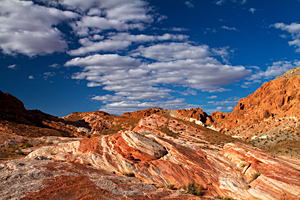
|
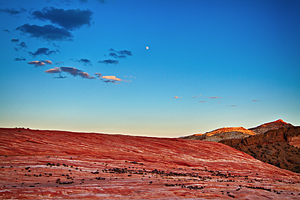
|
| Formation Along the Trail | Volcanic Bombs on Sandstone |
As the guide-book warned, the Fire Wave was much smaller than we expected. The Fire Wave outcropping is less than 75 feet tall, and the top surface is nearly filled with two people sitting on it. Nevertheless, it is unique and worth every bit of research required to finally find its location. The entire area of chaotic crossbedding and inner-woven bands of tan and orange kept pulling us in different directions, no matter where we looked. The moon rising just before sunset added an additional subject to our photography. Tonight was our practice run. Tomorrow night, the lighting will be better for moonrise, and we'll try to improve our shooting angle for the Fire Wave to increase the separation from the ridge behind it.
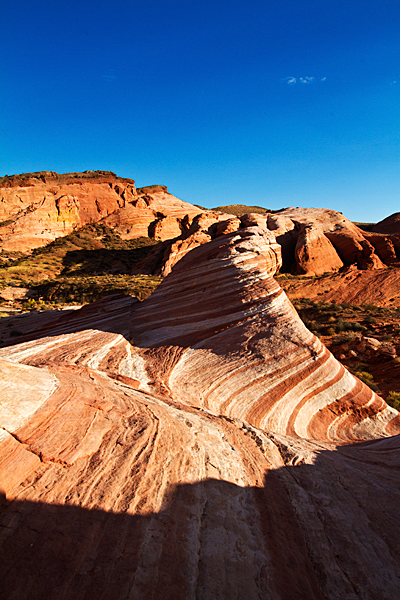
We're truly roughing it on this trip. Last night, we had grilled flank steak for dinner. Tonight, our main entree was shrimp scampi. This is a far cry from camping trips in a tent and cooking on a Coleman stove.

